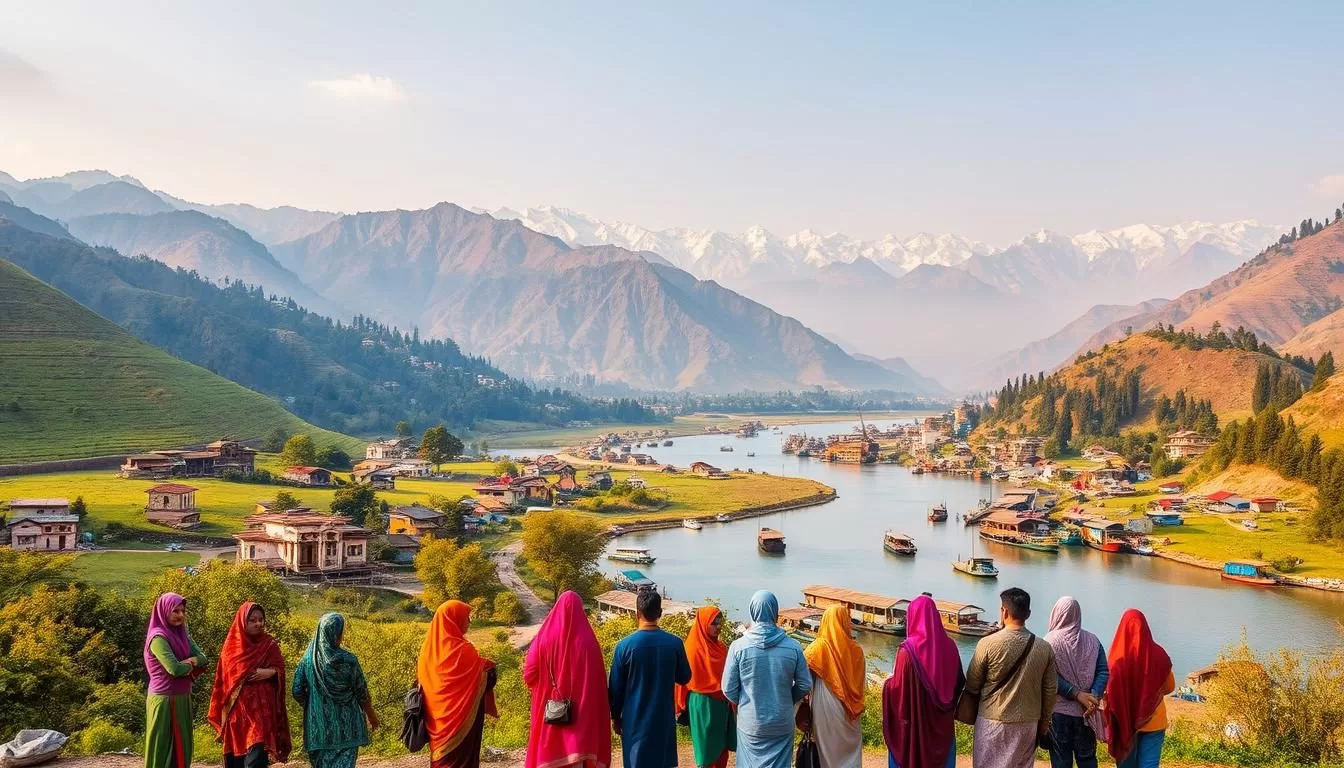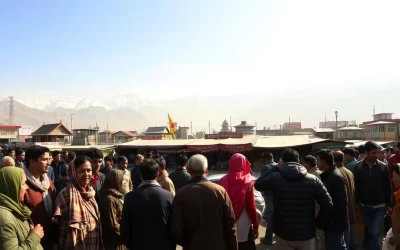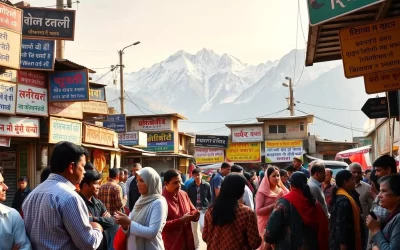You are about to explore a region with a rich cultural heritage and a complex history, reflected in its diverse linguistic landscape. The union territory of Jammu and Kashmir, located in northern India, has undergone significant administrative changes since 2019.
In 2020, the Parliament of India recognized five languages as official: Kashmiri, Dogri, Hindi, Urdu, and English. This multilingual character stems from the region’s geographical position at the crossroads of South and Central Asia.
Understanding the language dynamics in this region provides valuable insights into its cultural identity and historical development. You’ll gain a deeper understanding of the official language and its significance in the region.
The Linguistic Landscape of Jammu and Kashmir
You will find that the linguistic landscape of Jammu and Kashmir is characterized by a multitude of languages and dialects, reflecting the territory’s complex cultural history and geographical diversity.
Geographical and Cultural Context
Jammu and Kashmir, with its diverse geography, ranging from the Kashmir Valley to the Jammu region, hosts a variety of linguistic traditions. The territory’s cultural heritage is deeply intertwined with its linguistic diversity, influenced by its strategic location and historical trade routes.
The region’s complex history, with various rulers and empires, has contributed to its linguistic richness. As a result, languages belonging to different families coexist, creating a unique linguistic environment.
Language Diversity in the Region
The linguistic diversity of Jammu and Kashmir is marked by the presence of several Indo-Aryan languages, including Kashmiri, Dogri, Hindi, and Urdu. Kashmiri, spoken by approximately 6.8 million people, predominantly in the Kashmir Valley, forms the majority among its speakers.
| Language | Speakers | Region |
|---|---|---|
| Kashmiri | 6.8 million | Kashmir Valley |
| Dogri | varies | Jammu region |
| Urdu | official use | Administrative |
Each of these languages has developed its own literary and cultural expressions, contributing to the rich tapestry of the region’s linguistic landscape. The distribution of languages follows geographical patterns, with Kashmiri being predominant in the Kashmir Valley.
Historical Evolution of Languages in Jammu and Kashmir
The region’s diverse cultural heritage is reflected in its linguistic history. As you explore the evolution of languages in this region, you’ll discover how various historical periods have contributed to its current linguistic landscape.
Pre-Islamic Language Influences
Before the advent of Islam, the languages spoken in Jammu and Kashmir were heavily influenced by Sanskrit and other regional languages. The ancient Sharada script was used for writing Kashmiri and other local languages. This period laid the foundation for the linguistic diversity seen in the region today.
Persian and Mughal Period Impact
The introduction of Islam in the 14th century brought significant changes to the linguistic landscape. Persian became the language of administration and literature during the Mughal period, influencing local languages like Kashmiri. This period saw the adoption of the Perso-Arabic script for writing Kashmiri, which is still in use today. The Dogra period (1846-1947) saw Urdu replacing Persian as the official language in 1889, marking a significant shift in language policy.
Colonial and Post-Independence Language Shifts
The colonial era introduced English as a language of education and administration, which continued to play a significant role post-independence. After India gained independence in 1947, Urdu was adopted as the official language of the state, while recognizing the importance of regional languages like Kashmiri and Dogri. The special status of Jammu and Kashmir under Article 370 allowed for unique language policies. In 2020, Kashmiri gained official status in the Union Territory, highlighting the ongoing evolution of language policies in the region.
Jammu and Kashmir (UT), India: Official and widely spoken languages
The official and widely spoken languages in Jammu and Kashmir play a significant role in shaping the union territory’s administrative and social fabric. As you explore the region, you’ll notice that language plays a crucial role in its cultural identity.
The 2020 Official Language Act
The 2020 Official Language Act has been a significant step in defining the linguistic landscape of Jammu and Kashmir. This act has recognized the importance of various languages spoken in the region. The act aims to promote the use of official languages in administration, education, and other official purposes.
Some key aspects of the act include:
- Recognition of official languages for administrative purposes
- Promotion of linguistic diversity in education
- Use of official languages in judicial and other official contexts
Constitutional Status of Languages
The constitutional status of languages in Jammu and Kashmir has undergone significant changes, particularly after the reorganization of the former state into a union territory in 2019. The Indian Constitution’s language provisions now directly apply to Jammu and Kashmir, providing a legal foundation for multilingualism in the territory’s administration, education, and judicial systems.
Some key points regarding the constitutional status include:
- Kashmiri is one of the 22 scheduled languages of India, as per the Eighth Schedule of the Indian Constitution
- The constitutional framework protects the rights of linguistic minorities to preserve their language and culture
- The scheduled language status entitles languages like Kashmiri and Dogri to developmental support, including funding for literature and educational materials
Kashmiri: The Indigenous Language
As you explore the linguistic landscape of Jammu and Kashmir, the Kashmiri language stands out as a significant indigenous tongue. Spoken by millions in the Kashmir Valley, it is a vital component of the region’s cultural heritage.
Geographic Distribution and Speakers
The Kashmiri language is predominantly spoken in the Kashmir Valley. You will also find speakers in the surrounding regions, including the mountains to the south where Poguli and Kishtwari dialects are spoken. These dialects are closely related to Kashmiri and are sometimes considered dialects of the language.
| Dialect | Region | Speakers |
|---|---|---|
| Kashmiri | Kashmir Valley | Majority |
| Poguli | South of Kashmir Valley | Localized |
| Kishtwari | South of Kashmir Valley | Localized |
Linguistic Features and Classification
The Kashmiri language belongs to the Indo-Aryan family. It has been influenced by various languages, including Persian and Sanskrit, reflecting the region’s historical connections. The language has a unique grammatical structure and vocabulary, shaped by its geographical isolation.
Dialects of Kashmiri
Kashmiri has several regional dialects that vary in pronunciation, vocabulary, and some grammatical features. The standard dialect is based on the speech of Srinagar, the cultural center of the Kashmir Valley. Other dialects, such as those spoken in Muzaffarabad and Neelam Valley, have developed distinct features while remaining intelligible with the standard form.
You can observe that geographical isolation has contributed to the development of these dialects, with communities in mountainous regions developing unique speech patterns. However, factors like education and media exposure are gradually reducing dialect differences, leading to some standardization of the language across the region.
Dogri: Language of the Dogra Region
As you explore the linguistic diversity of Jammu and Kashmir, you’ll discover Dogri, a significant language of the Dogra region. Dogri is part of the Western Pahari group within the Indo-Aryan language family, sharing linguistic features with other Pahari languages spoken in the western Himalayan region.
Historical Background and Development
Dogri has a rich historical background, with its development influenced by geographical and cultural factors. It shows close affinities with Punjabi, particularly in phonology and basic vocabulary, due to geographical proximity and historical connections.
Current Usage and Distribution
Today, Dogri is spoken in the Dogra region of Jammu and Kashmir. Its usage is widespread among the local population, and it plays a significant role in the cultural and social fabric of the community.
Relationship with Other Indo-Aryan Languages
Dogri is closely related to other Indo-Aryan languages, with comparative studies providing valuable insights into the historical development of this language group. The table below summarizes the relationship between Dogri and other languages within the Indo-Aryan family.
| Language | Family/Linguistic Group | Similarities with Dogri |
|---|---|---|
| Dogri | Western Pahari, Indo-Aryan | – |
| Punjabi | Indo-Aryan | Phonology, Basic Vocabulary |
| Kashmiri | Dardic, Indo-Aryan | Distant, Different Historical Development |
Understanding Dogri and its place within the language family provides insights into the linguistic diversity of Jammu and Kashmir. As you continue to explore the languages of this region, you’ll appreciate the complex interconnections between different linguistic groups.
Urdu: A Language of Administration and Literature
The significance of Urdu in Jammu and Kashmir extends beyond its role as a means of communication to being a vital part of the region’s administration and literature. As you explore the linguistic landscape of this region, you’ll find that Urdu has been intricately woven into the fabric of local culture and governance.
Historical Significance in Jammu and Kashmir
Urdu’s historical significance in Jammu and Kashmir is deeply rooted in the region’s cultural and administrative history. It has been a language of rulers and administrators, playing a crucial role in the Mughal and later periods. The language gained prominence due to its association with the ruling classes and its use in official capacities. Over time, Urdu became a symbol of cultural sophistication and literary excellence in the region.
Current Usage in Administration and Education
Today, Urdu continues to be an important language in the administration of Jammu and Kashmir. It is used in official communications and government affairs, alongside other recognized languages. In the education sector, Urdu is taught as a subject and is also used as a medium of instruction in some institutions. The continued relevance of Urdu in these spheres underscores its enduring importance to the people of the region.
| Domain | Usage of Urdu |
|---|---|
| Administration | Official communications, government affairs |
| Education | Taught as a subject, medium of instruction |
| Literature | Poetry, prose, religious literature |
Cultural Impact and Literary Traditions
Urdu has had a profound impact on the cultural landscape of Jammu and Kashmir, particularly in the realm of literature. The language has been a vehicle for cultural expression across religious communities, with contributions to poetry, prose, and religious literature.  The rich literary tradition of Urdu in the region is a testament to its versatility and the creativity of its writers. Cultural institutions have supported Urdu literature through various initiatives, ensuring its continued relevance.
The rich literary tradition of Urdu in the region is a testament to its versatility and the creativity of its writers. Cultural institutions have supported Urdu literature through various initiatives, ensuring its continued relevance.
As you delve deeper into the cultural significance of Urdu, you’ll discover its influence on performing arts, visual arts, and crafts in the region. The language’s script and calligraphic traditions have also played a significant role in shaping the aesthetic sensibilities of local art forms.
Hindi: National Language and Regional Presence
In Jammu and Kashmir, Hindi serves as a vital link language, facilitating communication across various linguistic communities. You will find that its presence varies significantly across different regions.
Adoption as an Official Language
Hindi has been adopted as an official language in the region, alongside other local languages. This adoption has been influenced by its status as one of the official languages of the Government of India, with the Devanagari script being used for its written form. The education system has played a crucial role in promoting Hindi, as it is taught as a compulsory subject in many schools throughout the union territory.
Usage Patterns and Speakers
The usage of Hindi in Jammu and Kashmir is more prevalent in certain areas, such as the Jammu division, compared to the Kashmir Valley. It primarily functions as a second or third language for most speakers, serving as a common means of communication among people from different linguistic backgrounds. Urban centers and areas with significant migration from Hindi-speaking regions show higher rates of Hindi usage and proficiency among the population. Factors such as media consumption patterns, government employment requirements, tourism, and commerce have also contributed to its spread across different languages spoken in the region.
- Hindi usage varies significantly by region.
- Urban centers show higher rates of Hindi proficiency.
- Media consumption has influenced Hindi usage.
English: Language of Opportunity and Governance
In Jammu and Kashmir, English has emerged as a crucial language for governance and opportunity. As the union territory navigates its administrative and economic landscape, the importance of English is becoming increasingly evident.
Role in Administration and Higher Education
English plays a vital role in administration and higher education in Jammu and Kashmir. The language is used in official communications, government offices, and educational institutions. The growing information technology and service sectors in the union territory prioritize English communication skills, creating economic incentives for language acquisition.
Many institutions of higher education in the region use English as the primary medium of instruction, making it essential for students to have a good command of the language to access quality education.
Socioeconomic Implications of English Proficiency
English proficiency has significant socioeconomic implications in Jammu and Kashmir. It is increasingly viewed as a pathway to economic opportunity, influencing educational choices and career aspirations. A socioeconomic divide often exists between those with access to quality English education and those without, influencing social mobility patterns.
| Aspect | Impact of English Proficiency |
|---|---|
| Education | Access to quality education and better career opportunities |
| Employment | Increased chances of employment in IT and service sectors |
| Social Mobility | Influences social mobility patterns, creating a divide between those with and without English proficiency |
As the world becomes more interconnected, the global reach of English connects the people of Jammu and Kashmir to worldwide information networks, academic resources, and professional opportunities, making it a valuable asset for the territory.
Writing Systems and Scripts in Jammu and Kashmir
You might be surprised by the variety of scripts used in Jammu and Kashmir, each with its own history and significance. The region’s linguistic landscape is characterized by a diverse array of writing systems, reflecting its rich cultural heritage.
The Perso-Arabic Script for Kashmiri
The Perso-Arabic script has been increasingly used to write Kashmiri, especially since the 19th century. This script has become a significant part of Kashmiri literature and is widely used in various forms of media. The use of Perso-Arabic for Kashmiri has been instrumental in promoting the language, with many literary works and publications adopting this script. As a result, the Perso-Arabic script has become an integral part of Kashmiri cultural identity.
Devanagari Usage
Devanagari is another script used for writing Kashmiri, particularly among the Kashmiri Pandit community. The use of Devanagari has been encouraged as a way to preserve the language and its cultural heritage. Many Kashmiri texts have been transliterated into Devanagari, making it easier for new generations to learn and appreciate their linguistic roots. The adoption of Devanagari has also facilitated the study of Kashmiri language and literature in academic circles.
The Ancient Sharada Script
The Sharada script holds a special place in Kashmir’s cultural history, having been used from the 8th century AD until the early 20th century for both Sanskrit and Kashmiri. Although its use has declined with the advent of other scripts, Sharada remains significant for its historical and cultural importance. Today, it is primarily used in religious ceremonies and rituals among Kashmiri Pandits. Efforts are being made to preserve the knowledge of this ancient script through academic studies and cultural heritage initiatives.
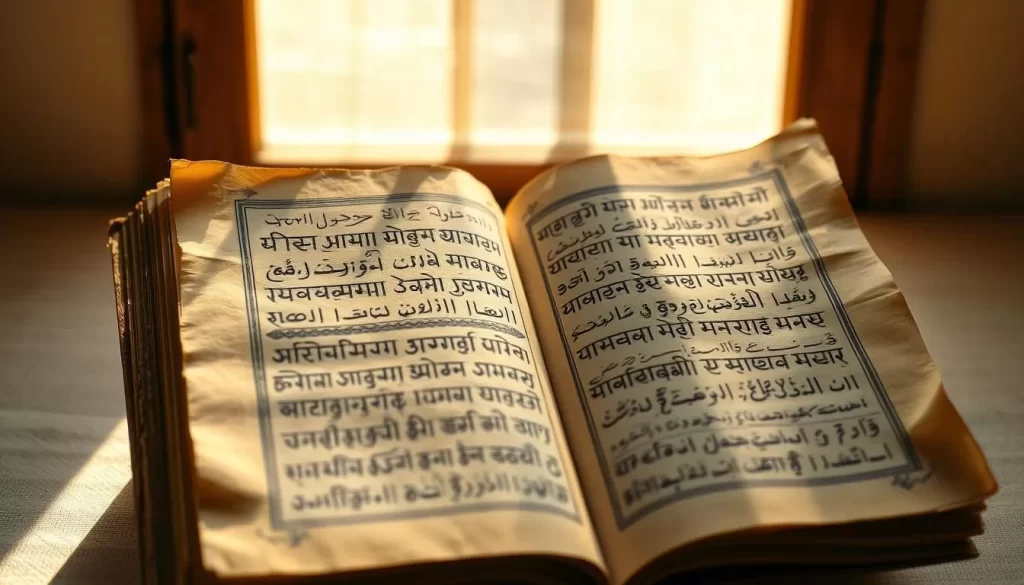
The diverse scripts used in Jammu and Kashmir reflect the region’s complex linguistic and cultural identity. Understanding these scripts is crucial for appreciating the region’s heritage and its people’s cultural practices.
Phonology and Unique Features of Kashmiri
As you explore the Kashmiri language, you’ll discover its distinct phonological characteristics that set it apart from other Indo-Aryan languages. The Kashmiri language has preserved several archaic features, making it a fascinating subject for linguistic study.
Vowel System
The vowel system in Kashmiri is noteworthy for its simplicity and distinctiveness. Kashmiri vowels exhibit a range that is characteristic of the language’s phonological uniqueness. The language maintains a set of vowels that are integral to its pronunciation.
Consonant Inventory
The consonant inventory of Kashmiri is another area where the language shows its divergence from mainstream Indo-Aryan languages. Notably, Kashmiri has partially maintained the three sibilant consonants (s, ṣ, ś) from the Old Indo-Aryan period, a feature that is rare in modern Indo-Aryan languages.
Distinctive Phonological Features
Kashmiri exhibits several distinctive phonological features, including the retention of the dental stop /d/ in numerical prefixes, as seen in “dusatath” for seventy-two. This contrasts with the /b/ development in most other Indo-Aryan languages. Additionally, Kashmiri lacks the /s/ > /h/ consonant shift that occurred in Vedic Sanskrit, preserving original /s/ sounds in certain words. These features provide valuable insights into the historical development of the language.
Other Languages Spoken in the Region
You will find that the territory of Jammu and Kashmir is characterized by a rich tapestry of languages, including several minority languages. These languages not only add to the cultural diversity of the region but also reflect the complex history and geography of the territory.
Pahari-Pothwari
Pahari-Pothwari is another significant language spoken in the region, contributing to the linguistic diversity of Jammu and Kashmir. It is spoken by a considerable population and is an important part of the cultural identity of the area. Pahari-Pothwari is closely related to other languages spoken in the surrounding regions.
Punjabi Influence
The influence of Punjabi can also be observed in certain areas of Jammu and Kashmir, particularly due to geographical proximity and cultural exchange. Punjabi has contributed to the linguistic landscape, with many people in the region being familiar with the language. This has facilitated communication and cultural exchange between the communities.
Minority Languages and Dialects
Several minority languages and dialects are spoken in Jammu and Kashmir, including Gojri, Bhadarwahi, Paddari, Sarazi, Shina, and Balti. These languages are spoken by smaller communities and are often confined to specific areas. For example, Gojri is spoken by the Gujjar community, while Shina is spoken in the northern areas, particularly in parts of the Gurez valley.
- Gojri is a significant minority language with hundreds of thousands of speakers.
- Bhadarwahi, Paddari, and Sarazi form a group of minority languages spoken in the mountainous districts.
- Many of these minority languages lack official recognition and educational support.
Efforts are being made to document and preserve these minority languages, with academic institutions and community organizations working together to record and maintain linguistic diversity.
Language Shift and Preservation Efforts
The linguistic landscape of Jammu and Kashmir is undergoing a significant transformation, with efforts to preserve indigenous languages gaining momentum. As you explore the region’s linguistic diversity, you will find that maintaining the delicate balance between language shift and preservation is crucial.
Challenges to Indigenous Language Maintenance
Indigenous language maintenance in Jammu and Kashmir faces several challenges, including the influence of dominant languages and the impact of urbanization. The Kashmiri language, for instance, is one of the 22 scheduled languages of India, and its preservation is of paramount importance.
The Jammu Kashmir government has recognized the need to preserve its linguistic heritage, but the task is complex. As you delve deeper, you will see that the challenges are multifaceted, involving socio-cultural, economic, and political factors.
| Challenge | Description | Impact |
|---|---|---|
| Urbanization | Movement of people to urban areas | Reduced usage of indigenous languages |
| Dominant Languages | Influence of languages like Urdu and English | Shift away from indigenous languages |
| Lack of Documentation | Insufficient written records of indigenous languages | Difficulty in preservation efforts |
Government and Community Initiatives
In response to these challenges, the Jammu Kashmir government, along with community organizations, has launched several initiatives aimed at preserving the region’s linguistic heritage. The inclusion of Kashmiri and Dogri in the Eighth Schedule of the Indian Constitution has provided national-level support for these languages, including funding for development activities.
Some of the key initiatives include the development of textbooks in regional language, incorporation of these languages into school curricula, and the establishment of the Jammu and Kashmir Academy of Art, Culture and Languages to promote linguistic and cultural preservation.
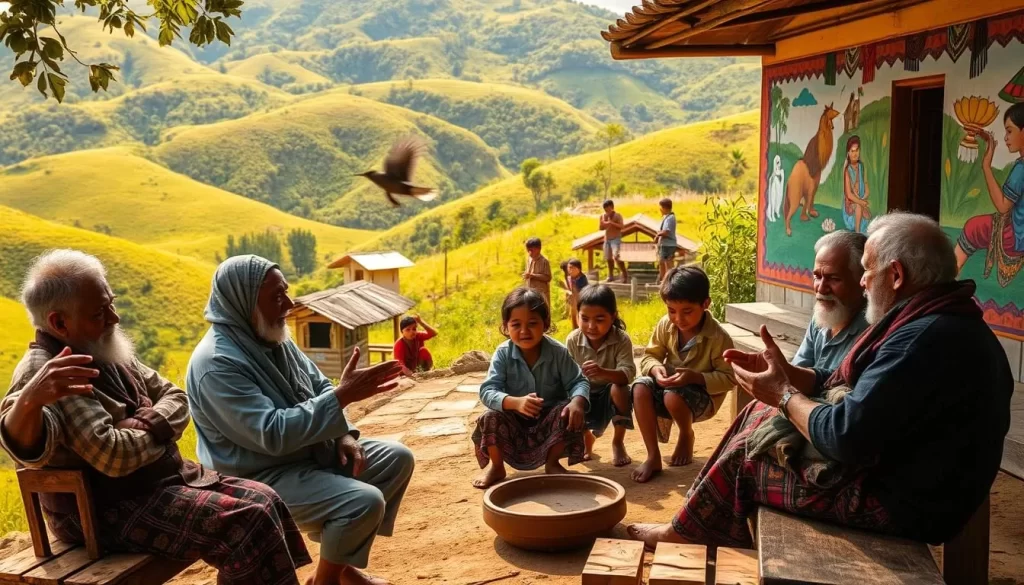
Religious Dimensions of Language Use
The religious dimensions play a significant role in shaping language use in Jammu and Kashmir. The region’s linguistic landscape is characterized by a complex interplay between language, script, and religious identity. Historically, the Perso-Arabic script has been used by both Muslim and Hindu Kashmiri speakers, demonstrating that script usage can transcend religious boundaries.
However, in recent decades, there have been efforts to associate the Perso-Arabic script with Muslim identity and the Devanagari script with Hindu identity, particularly for writing Kashmiri. This shift is reflected in the preferences of different communities.
Language Preferences Among Different Communities
Language preferences in Jammu and Kashmir vary among different religious communities. Some key observations include:
- The Kashmiri Pandit community, especially after migrating from the Valley in the 1990s, has increasingly adopted the Devanagari script for writing Kashmiri.
- Religious texts and educational materials often reinforce script associations, with Islamic texts using the Perso-Arabic script and Hindu religious materials using Devanagari.
- The Sharada script, though now rarely used, maintains cultural significance for Kashmiri Pandits, who preserve it for specific religious and ceremonial purposes.
Script Choices and Religious Identity
The choice of script in Jammu and Kashmir is often linked to religious identity, although this relationship is not always straightforward. The use of the Perso-Arabic script for Kashmiri has been associated with Muslim identity, while the Devanagari script is linked to Hindu identity. However, digital technology has made multiple writing systems more accessible, allowing individuals to choose scripts based on context rather than exclusively using one.
Key aspects influencing script choices include:
- Religious texts and educational materials.
- Cultural and ceremonial practices.
- Community preferences and identity.
Language Education in Jammu and Kashmir
In Jammu and Kashmir, the structure of language education plays a significant role in shaping the linguistic identity of its populace. The region’s educational system is designed to promote linguistic diversity while ensuring proficiency in multiple languages.
School Language Policies
School language policies in Jammu and Kashmir are geared towards fostering multilingualism. Students are typically taught in their mother tongue or regional language, alongside compulsory instruction in other languages such as Hindi and English. This approach helps students develop a strong foundation in their native language while acquiring proficiency in other languages.
The curriculum includes the study of various languages, reflecting the region’s linguistic diversity. For instance, Kashmiri, Dogri, and Urdu are part of the curriculum in different schools, depending on the region.
Higher Education and Language of Instruction
Higher education in Jammu and Kashmir predominantly uses English as the medium of instruction, especially for scientific, technical, and professional courses. However, universities in the region also offer language and literature programs in multiple languages, including the official languages of the union territory.
| Language | Program Offerings | Institutions |
|---|---|---|
| Kashmiri | Language and Literature | University of Kashmir |
| Dogri | Language and Literature | University of Jammu |
| Urdu | Language and Literature | Universities across Jammu and Kashmir |
Research on regional languages is conducted at institutions like the University of Kashmir and University of Jammu, contributing to language documentation and development. Translation programs work to make academic content available in regional languages, though English remains dominant for advanced studies.
Linguistic Challenges in a Contested Region
Linguistic diversity in Jammu and Kashmir is both a richness and a challenge in the contested region. The territory’s complex history and geopolitical situation have resulted in a multilingual landscape, with various languages and dialects being spoken across different areas.
The presence of multiple languages, including Kashmiri, Dogri, Urdu, Hindi, and English, contributes to the region’s cultural richness. However, it also poses challenges in terms of language policy, education, and communication.
Political Implications of Language Policies
Language policies in Jammu and Kashmir have significant political implications. The choice of official languages and the promotion of certain languages over others can be a sensitive issue, reflecting broader political and cultural tensions.
For instance, the adoption of Urdu as an official language has historical roots, but it also raises questions about the status of other languages spoken in the region. You need to consider the impact of such policies on the linguistic identity of different communities.
Cross-Border Linguistic Connections
Despite the political divisions, there are significant linguistic connections across the Line of Control. Languages like Kashmiri are spoken on both sides, creating cultural continuities.
The Kashmiri dialect spoken in the Neelam Valley of Pakistani-administered Kashmir shares features with the dialect of northern Kashmir Valley, particularly Kupwara. 
- Linguistic connections across borders create cultural continuities despite political divisions.
- Dialect variations show interesting patterns, with shared features across different regions.
- Pahari-Pothwari language varieties form a dialect continuum that crosses political boundaries.
- Media consumption and digital communication have created new opportunities for cross-border linguistic exchange.
Conclusion: The Future of Linguistic Diversity in Jammu and Kashmir
As we look to the future, the linguistic landscape of Jammu and Kashmir is poised to continue its rich tradition of multilingualism. The 2020 Official Languages Act has provided a framework for language coexistence, ensuring that multiple languages can thrive in the region.
The vitality of the Kashmiri language is evident in its status as the second-fastest growing language in India, according to the 2011 census. This growth is a positive indicator for the indigenous language, despite historical challenges. Furthermore, digital technologies are offering new opportunities for language preservation and revitalization, making languages more accessible through online platforms, mobile applications, and digital archives.
Educational reforms that incorporate mother-tongue instruction and multilingual education could strengthen language maintenance across generations. The economic value of regional languages may also increase as cultural tourism, publishing, and media production in these languages expand. However, continued political developments in the region will likely influence language policies and practices, presenting both challenges and opportunities for linguistic diversity.
Community-based language initiatives will remain crucial for maintaining smaller languages and dialects. The global recognition of linguistic diversity as cultural heritage may provide additional support for preservation efforts in Jammu and Kashmir. As the region navigates the balance between global connectivity through languages like English and local identity through regional languages, it will continue to shape language choices in education, administration, and daily life.
The above is subject to change.
Check back often to TRAVEL.COM for the latest travel tips and deals.
